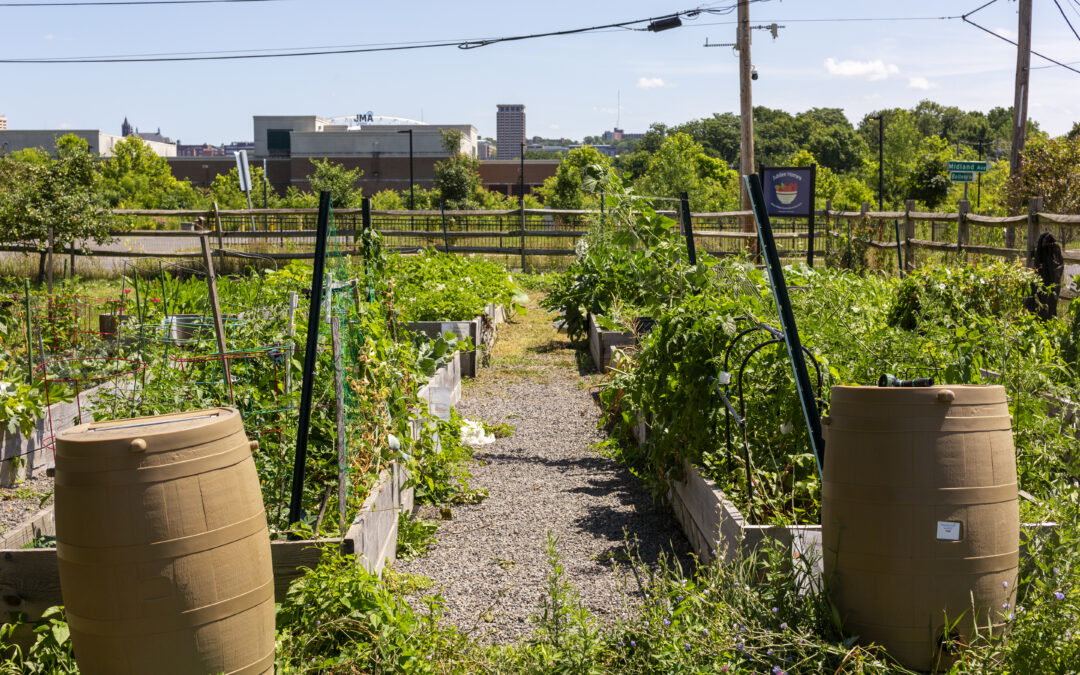The Saturday of the Urban Garden Tour was a perfect summer day in Syracuse, NY. The sun shone through clear skies, and the day begged for laughter, for curiosity, for being outdoors. Syracuse-Onondaga residents took up the day’s call and turned out to tour 13 home gardens, community gardens and urban farms within the city limits.

The Syracuse Urban Garden Tour is a yearly event co-hosted by the Syracuse-Onondaga Food Systems alliance and Syracuse Grows, and planned, in large part, by inspired community members through the Urban Agriculture Working Group. It is an opportunity for gardeners of all stripes to show off their hard work, and for tour participants to ask questions, learn about growing practices, and be inspired by the ways folks across the city are growing food in urban settings.
The tour kicked off at the “Hub,” where SOFSA tabled along with other community organizations at the Food Access Healthy Neighborhoods Now Saturday Farmers Market. The market is a crucial response to the lack of access to fresh food in the Valley neighborhood of Syracuse, where the only supermarket in the area closed down in 2018. Situated at the Valley Plaza (4141 S Salina St) the market aims to fill in some of this gap by inviting both food vendors like Brady Farm and community organizations who can provide information on health and wellness to patrons. The existence of the market supports and is supported by urban agriculture efforts, as small farms in the area provide fresh produce that patrons can purchase using different government benefits programs.
After visiting the market and getting their physical maps, participants in the tour were sent on their way to explore the urban gardens in a choose-your-own adventure style tour. At each site, gardeners received visitors with excitement, and shared about how they created the space, answering questions and offering small treats to folks.
Participating sites included a handful of community gardens where the food grown is meant to directly support the nutritional needs of neighbors. Some of these beautiful projects are stewarded intergenerationally, with garden elders passing on leadership of the space to younger growers, and working together to increase engagement and buy-in from the community. Events like the Urban Garden Tour highlight the important role that these gardens play as both sites of community-building and food acquisition for the folks tending them and their extended networks.
Other sites included home gardens and gardens tended by community members organized in collective housing structures. These gardens mostly feed the households they belong to, though excess produce often makes it way into the hands of gleeful neighbors. The ways in which these home gardens activate whole families and collectives is truly inspiring. The gardens serve as sites of learning for kids, as mindfulness spaces for adults to connect with the earth, as experimental laboratories where moving slowly and intentionally are the only ways forward. Hearing stories of how the gardens have grown over the years, starting with one garden bed and growing to five (or ten), integrating ducks and other animals, affirms the importance of placemaking and personal investment in building up the futures we want to see.
Finally, the inclusion of urban farms on the tour introduced a different kind of scale for urban food production. The small farms featured on the tour, Brady Farm and Urban Delights Learning Farm, are testaments to the sustaining potential of urban space. These farms grow enough food to feed dozens, if not hundreds, of people. Because of their size, their stewards have to be creative and intentional with the use of space and the conservation of resources: employing crop rotation, diversification of crops, and other more sustainable growing practices. Both of these farms also serve as workforce development sites, where young folks (especially so in the case of Urban Delight Learning Farm) can practice growing, marketing, planning, research and more through the context of growing and providing food to the community.
Though these gardens can seem small in the grand scheme of things, their existence points to a continued desire to connect with nature, to practice self determination in our food system, and to expand access to fresh produce that is both culturally appropriate and affordable. For these reasons and more, the organization of the tour is a regular undertaking of the Urban Agriculture Working Group, a convening space hosted and facilitated by SOFSA. Here, members of the community interested in urban agriculture, whether it be community gardens, urban farms, or home gardens, come together to brainstorm and plan how to better resource growers in the area, with the aim of growing more food right in the city.









